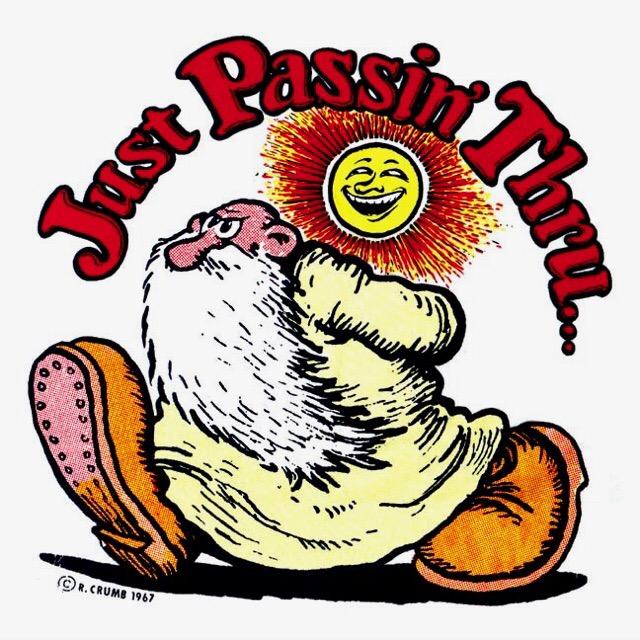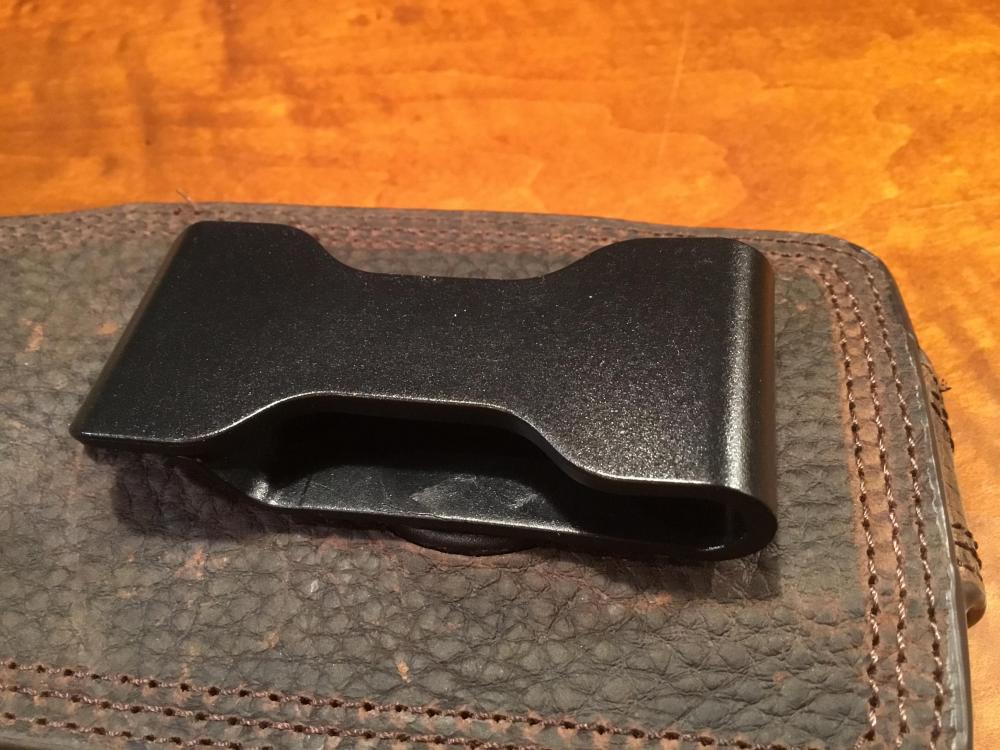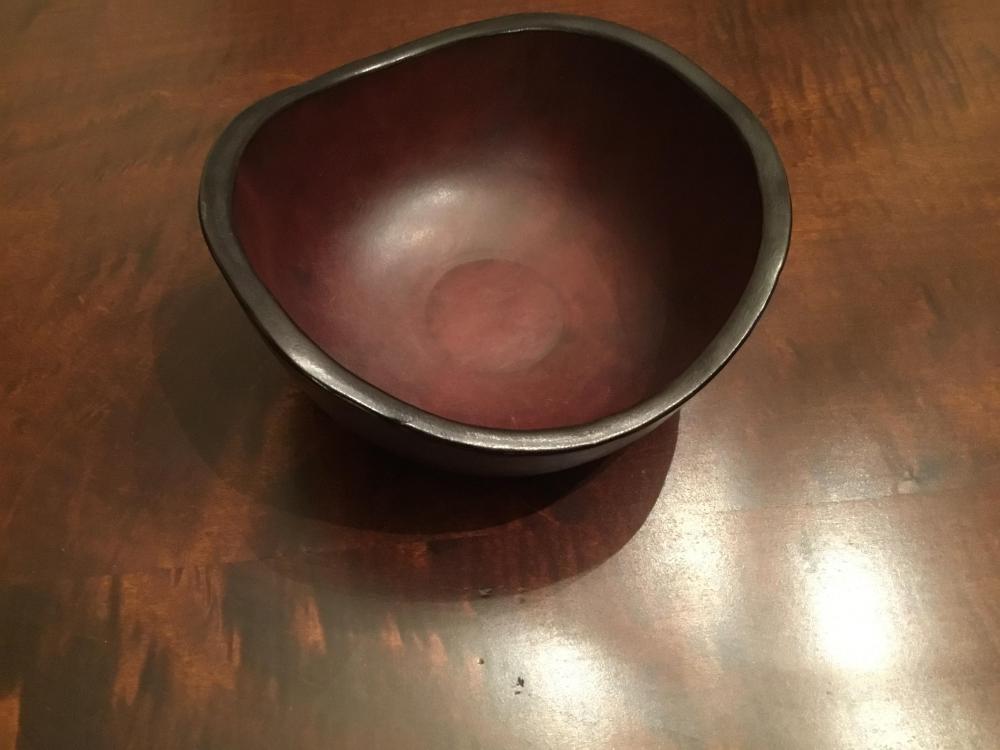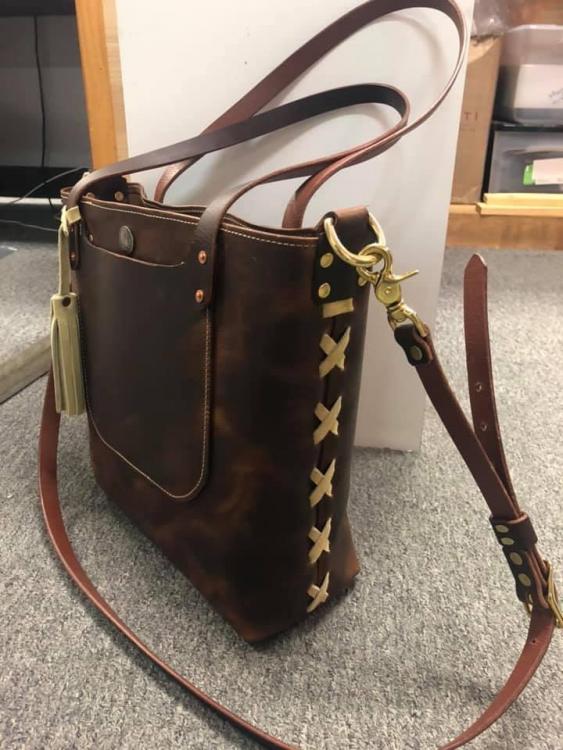
klutes
-
Content Count
156 -
Joined
-
Last visited
Posts posted by klutes
-
-
-
For the belt makers that make the belts with brass name tags. I am curious how many people use raw brass tags vs brass tags with a lacquer finish on them. I am have always used the lacquered finished tags. But given some thought to switching. Just curious what the ratio is.
-
Would love to see your work. Welcome aboard
-
Don’t give up on it. They are really good machines. I have and use two of them. One set up with 135 and one with 69.
-
Are you glueing two pieces up letting it dry them soaking in water to wet form mold???
-
Wow Shows everyone’s sniffer is different. I find that tragacanth and neatsfoot oil has very little odor. Sorry for you having such issues. Must me rough having that condition.
-
2 hours ago, sandmanred said:I synched mine, I agree with you I don't know it might be useful to have them not synched. I just rolled the hand wheel by hand and iterated until I got it dialed in.
It's been a while since I had mine but I think the hook is the same as a 31-15. I also got needle plate from ebay. It's good to know the clones/close models too when you search for parts. I think the Singer 16U is one and Tacsew T188 another. Watch the fit of parts that aren't OEM, they often kind of fit but I have had to modify many of them to make them work right.
Thanks
-
1 hour ago, DAkramer said:I had a Consew 18 until recently, I really enjoyed using it. it will take 135 thread all day long 225 is asking a lot of this machine my experience is you can get it to sew with it but the stiches don't look good otherwise it can sew through anything you can put under the foot. It will do up to about 1500 stiches per minute but it would be unwise to get much over that. You can find feet on ebay though they can be expensive and welting feet are available . Bobbins and bobbin cases are pretty much the same as domestic sewing machines and are pretty cheap. it takes a 135 type needle , common walking foot needle easy to find and cheap leather needles are available. I would just sync the upper feed with the lower feed for the stitch length I was using. The needle plate has a pretty big hole in it so when you get started it can hang up on the feed dog, just something to watch out for. The needle plates are easy to find on ebay the needle bar is also available and pretty cheap . I replaced the clutch motor with a servo motor it made all the difference especially since the old clutch motor was an ancient open motor design and was pretty "grabby" there isn't much to go wrong with this machine and once I managed to get the timing down I never had to adjust the timing again. This is a commercial machine and is well built if you keep it oiled every day you won't be needing to replace any parts. This machine does not have reverse so at the end of the seam lift the foot slide the material back under the foot a bit and put in a couple of stitches or turn the goods around and put in a couple of stitches.
I would post pictures but I don't know how to on this platform.
Dave
Thanks
-
I received the Consew 18 today by fedex. I will have to say I am surprised how great the condition is. Apparently it has been used very very little. I have not found any wear at all. I am going to set it up with a servo motor. Should I set it up with a speed reducer. I am planning on setting it up with small needle and thread for sewing billfolds.
Also can someone explain why the machine I set up with dual feed adjustment. One for the bottom feed and one for the top feed. Why would you want these to ever be different. Am I missing something or is this just a way to adjust both feeds to be in sync??I have heard parts can be sorta hard to fine for this machine. Is there anywhere you can find them in case I ever needed something.
-
3 hours ago, Constabulary said:I have to apology - I mixed up Consew 18 and Consew 28 - Singer 78 is similar to the Consew 28 but not to the 18 - I`M SORRY!
I think DonInReno is right - the Consew 18 is like the Singer 16-188
Again - sorry - my bad! So forget what I have written.

No problem
-
3 hours ago, sandmanred said:I had the Consew 18 for short while but I'm pretty sure it will handle T135 all day long and I think I even tried some T210 with a 24 needle but had a modified needle plate to allow the bigger needle to pass. 92 should be no problem.
Thanks
-
4 hours ago, Constabulary said:The Singer 78 / Consew 18 have a driven top feed and needle feed but no feed dog (does not mark the leather on the bottom side). Max. stitch length is approx 8 - 8.5mm (not many in this class have such a long stitch length), machine has no reverse and foot lift is approx 8mm. Max. needle size is 140. Problem is you barely find feet and parts for this machine and the few you find are very expensive. I owned one. But it is a really cool machine IMO but other than the stitch length it hat no advantages to my 111G156. But it was a pleasure to play with - really. If you can get one cheap buy it and try it out.
Thanks for the information. I am anxiously waiting on it to arrive. Just got it to play with and maybe do really light stuff with small needle and thread. Will it handle 92 thread
-
I have heard this but not sure.
-
1 hour ago, sandmanred said:Here's a link to a manual. Consew keeps a good library but I also use manualslib.com
I had one that I got from a musty basement. Rusted solid when I got it. Brought it back to life and it worked great. I think it runs up to a 23 needle? About 5 stitches per inch max. The needle it specified was not a easy one to find now but a needle bar adjustment let me adapt it to a readily available needle. I think it offered a differential feed, so you could over or underfeed the top layer of fabric relative to the bottom. It didn't do anything for me so I just ran the top and bottom feeds synched up.
http://www.consew.com/Files/112347/InstructionManuals/18.pdf
Thanks for the info and the link
-
Anyone familiar with the Consew 18 sewing machine. Any info it’s capabilities you could share on it would be appreciated. Thanks
-
Does anyone know where to get heavy duty hook plates for mechanics belts. Need something heavier than what Springfield sells. They are just stamped out of sheet metal. Or do you have any good ideals on how to make one. I have made a couple but always looking for something better
-
Good deal. I personally prefer the wooden forms over the other way. Just me I guess. It’s an almost forgotten way.
-
21 minutes ago, Dogfisher said:Wow. Thank you so much. I am on a mission now klutes!

Email me if you need to
-
Two layers of veg tan around 8 oz each
First thing first a form
-
I have used a lot of Weavers English bridle and still like it. But recently switched to WC. WC will take on water for casing the leather better than weavers. I case it for embossing. Plus I typically buy already stained and finished . Part of the reason why one takes on water more than the other. Due to the finishing process I assume. I get sharper embossing imprints on the WC.
and no trade secrets for me.
-
Look at the picture posted above. The one with the leather pulled over the wooden stump. That is the first step. Only you have to pull and work the leather down more than he has shown there. Other words about twice as many tack as he shows there. A lot of pulling and working out the wrinkles and water. You will not eliminate all of them. Let it dry for about 24 hours. Now repeat the process with second layer of leather. Flesh to flesh lots of glue. It’s a lot of work to get it worked down. Let it dry for 30-36 hours. Cut and remove. That in its self is a lot of work. Probably close to 200 tacks to remove. Lot of poked holes in the fingers. Finish the top edge as you normally would a piece of leather.
Also I always dye to color first. No real apparent reason just the way I do it.
It took me a while to get everything figured out.One more thing I forgot to mention. When you finally take it off the form. It is still damp inside the leather. It will feel pliable. Other word set aside for a couple of days and it will finish curing out and get a lot more firmer.
-
Afraid that I have never took pictures of the process to show.
-
-
English bridle





New Hermes engravograph
in Old/Sold
Posted · Edited by klutes · Report reply
New Hermes engravograph electric engraving machine. Perfect for brass tags for belts and dog collars. This one currently set up two lines of script for 3/4 wide brass tags. Can be set up for single line very easily. This is the one that has a adjustment setting for depth of cut. A really nice feature. I good condition. Pretty heavy for shipping prefer local pickup. Comes with two set of fonts. $475.00 central Ky